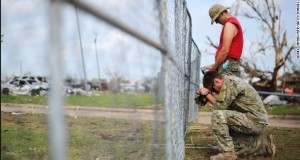When natural disasters take place, a great deal of attention is focused on the victims of the events. Property damage, casualties and the rescue of any survivors are the center of the news coverage, and while these pieces of the story are crucial to a complete understanding of the events, the efforts of those who respond to the crisis often remain behind the scenes.
As a result of the recent tornado tragedy in Oklahoma, the need for the “behind the scenes” worker was evident, and one of the organizations that has maintained a continuous presence when major catastrophic events occur is the National Guard.
Jay Webb, a training specialist with the Department of Defense has a complete understanding of emergency response; in particular, what happens during a national crisis. He works for a government contractor in Northern Virginia that provides extensive training for National Guard soldiers on emergency crisis response systems. Essentially, when major catastrophic events occur; events like Hurricane Katrina, Boston Marathon bombing, Super storm Sandy and similar events, he assists the National Guard units as they are deployed to assist and to maintain order in distressed areas.
“We work really hard over here to make sure we can get these guys where they need to be when things happen. We’ve recently ramped up for the inauguration, for pretty much any storm that comes through the east coast, and for the Boston Marathon incident. In my role I have to make sure that the units have the things they need to take care of the people in need and as a former soldier, I know how important logistics are to how the whole thing flows. When the tornados hit Oklahoma, we knew what to do.” Webb said.
In order to do this job effectively, Webb and his team of trainers work to ensure that the personnel in these units are fully prepared to implement their response tactics, and that they have the tools, equipment and personnel in place to do so quickly. This takes a great deal of preparation before crises occur to make sure the teams are ready to go.
“Sometimes,” Webb says, “we have to maintain several units in a specific area, and we have to make sure everything works together smoothly so that these units can get out there and rescue people, assist local law enforcement, build shelters, serve as tactical escorts; pretty much anything can happen and we need to be ready for whatever comes down the pipeline. We need to make sure people get back to their regular lives as soon as possible.”
When the tornado struck Oklahoma, Webb’s team sprung into action immediately, and initiated what is called the “response sequence.” This includes sending National Guard troops to the areas that need assistance and providing continuous support throughout the duration of the exercise.
“It is always difficult to deal with a scenario when lives are in danger. We work long hours and we have to facilitate a lot of fine moving parts to make this all work, but my team always looks at the bigger picture…we know we are working for some child, or for some family and we keep that in mind during those long hours. Most of us have families ourselves, and we know we would want someone working on our behalf if we were in need as well.”
